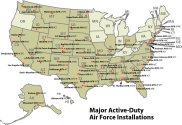I'm pretty skeptical that on the whole Chinese military infrastructure is significantly more hardened than US equivalent. A lot of targets are essentially civilian infrastructure such as ports, bridges, etc. Those are likely the same in both nations. As for actual military bases or airfields I don't really see any evidence that Chinese ones are somehow unusually better than American ones at damage control or being hardened. Neither do I see any evidence that Chinese military factories are more hardened than American ones. Do you have any evidence or citations for your assertion? Regardless the sheer number of targets in USA is staggering, a handful of H-20s would be a drop in the bucket. And again I maintain this is a pretty poor use of H-20, the PLAAF would be much better served using it closer to China.
As for land based air defense, it's not like USA doesn't have any, there are 15 Patriot battalions in service. That's like 400-500 launchers. That's not counting USN ships and such. So it's hardly like the US is particularly lacking in ground based air defense, in fact if we consider Patriots vs only HQ-9 and HQ-9B, the US probably has more.
Regarding the secondary effects, it's hard to predict how these things will play out. I'm very doubtful point 1 will apply, if the US is really committed to a major war with China then H-20s and/or few targets on the West Coast being blown up will not change that. However point 2 is plausible but again hard to predict and I'm not convinced US military infrastructure is much more vulnerable than Chinese equivalent.
While I'm ambivalent as to the utility of H-20 vs opportunity cost of other programs, Chinese efforts to harden infrastructure are both extensive and well documented.
The People’s Republic of China (PRC) expects airfields to come under heavy attack in a potential conflict and has made major investments to defend, expand, and fortify them.1 Since the early 2010s, the PLA has more than doubled its hardened aircraft shelters (HASs) and unhardened individual aircraft shelters (IASs) at military airfields, giving China more than 3,000 total aircraft shelters—not including civil or commercial airfields. This constitutes enough shelters to house and hide the vast majority of China’s combat aircraft. China has also added 20 runways and more than 40 runway-length taxiways, and increased its ramp area nationwide by almost 75 percent. In fact, by our calculations, the amount of concrete used by China to improve the resilience of its air base network could pave a four-lane interstate highway from Washington, DC, to Chicago. As a result, China now has 134 air bases within 1,000 nautical miles of the Taiwan Strait—airfields that boast more than 650 HASs and almost 2,000 non-hardened IASs.
To the best of my knowledge, a grand total of zero hardened aircraft shelters have gone up in CONUS since the end of the Cold War. A cursory search also yielded no evidence to the contrary, though I welcome any corrections in this regard.
As far as GBAD goes, the US is both overspecialized and lacking. Overspecialized in that it's majority BMD. Lacking in numbers, at least comparatively speaking. It's basically all concentrated in the US Army's Air Defense Artillery branch, which going off memory has:
- Four M-SHORAD battalions (and plans for another four)
- Three C-RAM battalions (and plans to transition to nine IFPC battalions)
- Fifteen Patriot battalions (and plans for one more)
- Seven THAAD batteries (and plans for one more)
- One GMD battalion
- Three LAAD battalions (technically under USMC, but hey)
Call it 33 GBAD battalions total, which are spread quite thinly across the entire world, from Germany to Guam. They're tasked with defending against everything from quadcopters to ICBMs. As per the Key West agreement with the Army, USAF does not operate any of its own GBAD.
Meanwhile PLAGF alone fields 78 battalions attached to combined arms brigades, plus another 13 dedicated brigades attached to group armies. And that's just the ground forces with short/medium stuff; we haven't even gotten to the 24 brigades under PLAAF which run the theatre-level IADS. A theatre which, needless to say, concentrates all of those assets in one country. There's really no comparison here; it's not even close.


